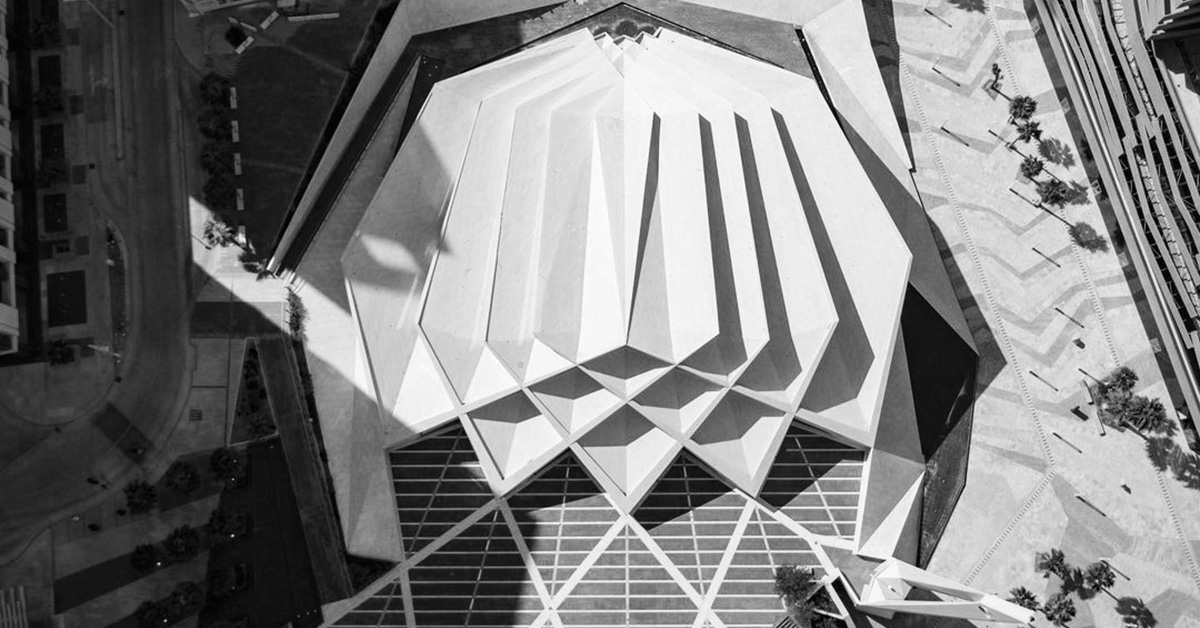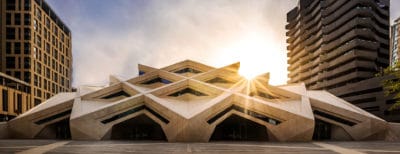 Aerial photo of the Grand Mosque in King Abdullah Financial District (KAFD), Riyadh, Saudi Arabia. Photo © Amjadpix via instagram.
Aerial photo of the Grand Mosque in King Abdullah Financial District (KAFD), Riyadh, Saudi Arabia. Photo © Amjadpix via instagram. .
Omrania’s award-winning design for KAFD Grand Mosque in Riyadh emerged in response to the surrounding urban fabric. Conceived as a 21st-century landmark —and the spiritual heart of the King Abdullah Financial District — the mosque offers a unified architectural experience from exterior to interior.
Mosques are well understood as spiritual spaces, but they also perform important urban and civic functions. Across the centuries, in cities across the world, mosques have served as urban focal points, gathering the life of the city around them.
It was in this spirit of connectivity that Omrania designed the KAFD Grand Mosque. This unique building, whose form is inspired by the crystalline “desert rose,” helps connect and center daily life in Riyadh’s premier mixed-use district, the King Abdullah Financial District (KAFD).
Indeed, the urban context was a primary driver for our design of this award-winning, 10,000-square-meter project. Omrania began our design process by analyzing the district’s master plan and studying its architectural language and scale. Taking inspiration from mosques that have served their communities for centuries, our team conceived of the KAFD Grand Mosque as more than a stand-alone building. With its generous plaza and dynamic form, it welcomes worshippers and connects with the urban fabric.
In 2021, Omrania received the Abdullatif Al Fozan Award for Mosque Architecture for our work on the KAFD Grand Mosque. The award addresses new ideas for mosque design in the Middle East and abroad. In this and other global architecture awards, the KAFD Grand Mosque has been recognized not just for its innovative form, but also for its contextual design which enriches the surrounding area.
The KAFD Grand Mosque is sited at the intersection of three large “wadi” paths lined with greenery, shops, and cafes. This means that people see the mosque’s dramatic form come into view as they go about their daily business. High above, the skyline is dominated by glass towers. Our response? Design the mosque to be seen from any angle, including from above. Thanks to the mosque’s sculptural form, the faceted walls transition seamlessly to the roof, seen from above as the “fifth elevation.”
But even more important than the view from on high is what happens at the ground level. With city dwellers in mind, we designed a mid-level Grand Mosque Plaza to bridge the sunken wadi below and the higher ground above. The plaza connects the urban fabric and provides a significant public space as well as an open-air prayer area for use on Fridays or holidays. At night, exterior lighting accentuates the crisp geometries of the mosque as a beacon for the KAFD community.








